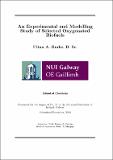An experimental and modelling study of selected oxygenated biofuels

View/
Date
2014-10-13Author
Burke, Ultan
Metadata
Show full item recordUsage
This item's downloads: 372 (view details)
Abstract
Detailed chemical kinetic models are useful tools for the development of more efficient
combustion systems. These models require validation of the elementary kinetics used in
order for them to be accurate and reliable. The range of pressures, temperatures, and
mixture compositions related to practical combustors means that these models need to be validated over a wide range of conditions. Shock tubes and rapid compression machines, such as the ones used during this study, are well suited to provide these validation data due to the well characterised conditions of temperature and pressure during these experiments.
This study aims to provide both the fundamental experimental data for model validation,
and accurate and robustly validated chemical kinetic models, in particular for oxygenated
biofuels.
Methane (CH4), dimethyl ether (DME), 80/20 CH4/DME and 60/40 CH4/DME in `air'
ignition delay times were recorded for p = 7-44 atm, T = 600-1600 K, and equivalence
ratios of 0.3-2.0. These ignition delay times show that as the concentration of DME
increases the ignition delay time decreases. The ignition delay times measured provide new validation targets at engine relevant conditions to validate a new chemical kinetic model.
This model incorporates updated thermochemical group values based on the calculations of Yamada et al. used for the calculation of the thermochemical data for DME combustion
species presented in this model (Mech 56.54). Pressure-dependent rate constants have
been applied for the first time to the main low-temperature reactions pertaining to the
oxidation of DME. High-level calculations and measurements have been applied to the
other major reactions of the DME mechanism where available. This model has been
validated not only against the new data collected but also against existing literature data in order to constrain the reaction rate constants and reduce the uncertainty in the assignment of the rate constants in the model. The result is a robustly validated mechanism, that can accurately predict the validation targets.
Methanol (CH3OH) is the simplest alcohol, and its reaction mechanism is well known.
However there is a lack of experimental data available for model validation at engine
relevant conditions. In this study ignition delay times have been recorded for CH3OH
concentrations ranging from 1.5-21.9%, at p = 2-50 atm, T = 850-1600 K, and
equivalence ratios of 0.5-2.0. The wide range of conditions studied allowed for the revalidation of a CH3OH chemical kinetic mechanism. At the high pressure conditions of the data measured, sensitivity was observed to the rate constant CH3OH + HO2 <=> CH2OH + H2O2. This rate constant is still disputed, with differences in the available quantum
chemical calculations ranging from a factor of 3 to an order of magnitude. The wide range
of validation data collected during this study helped to assign an optimum rate constant
for this reaction. The updated model was also validated against existing literature data.
Previous studies have shown tri-propylene glycol monomethyl ether (TPGME) to be
an effective soot reducing additive when used in research diesel engines. There is no
fundamental experimental data available for the validation of chemical kinetic mechanisms describing its oxidation. This study presents the first experimental data for TPGME at 0.25% TPGME, p = 10 and 20 atm, T = 980-1545 K, and for equivalence ratios of 0.5-2.0. These data are being used in the validation of a chemical kinetic mechanism
currently in development. The model agrees well with the ignition delay times measured.
Flux analyses showed that the fuel was being consumed mainly by molecular elimination
and H-atom abstraction reactions under the conditions studied.
2-Methylfuran (2-MF) and propene (C3H6) ignition delay times have also been measured.
2-MF measurements were taken at 1% 2-MF, p = 1 atm, T = 1200-1800 K and
over equivalence ratios of 0.5-2.0. C3H6 ignition delay times were measured for 0.89%
C3H6, 4.00% O2, p = 40 atm, T = 1175-1500 K. The 2-MF data was the first ever
measurements of its ignition delay times. This data provided valuable validation targets
for the development of a chemical kinetic model which was subsequently published. The
C3H6 data provided a cross-facility check with equivalent data from Stanford University
and was also used in the validation of a chemical kinetic mechanism which has also been published.
This study provides a large quantity of high-pressure ignition delay times for a wide
range of oxygenated compounds. It also provides chemical kinetic mechanisms for CH3OH and DME, the simplest alcohol and ether respectively, and can act as the basis for the further development of chemical kinetic mechanisms for alcoholic and ether compounds.

